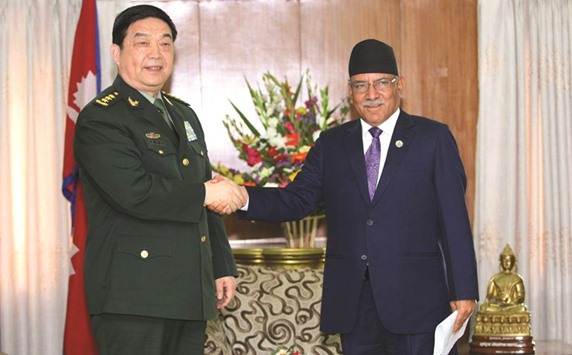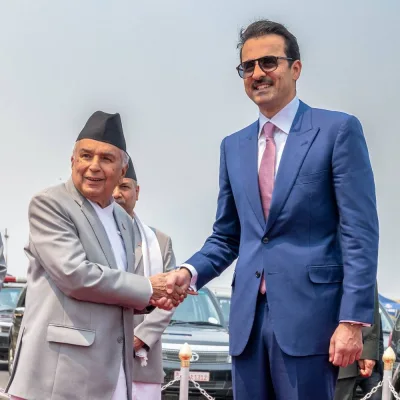Nepal and China have pledged to further develop their ties as Kathmandu expressed its willingness to join China’s Belt and Road initiative.
In a meeting with visiting Chinese Defence Minister and State Councillor Chang Wanquan recently, Nepalese Prime Minister Pushpa Kamal Dahal appreciated China’s neighbourhood diplomacy featuring amity, sincerity, mutual benefit and inclusiveness.
Dahal also thanked China for its assistance to Nepal’s socio-economic development and defence, especially the Chinese aid for post-quake
reconstruction.
“Nepal is committed to the one-China policy and it will always stand against anti-Chinese activities. Nepal is keen to be a partner of the Belt and Road initiative,” the prime minister said.
The Silk Road Economic Belt and the 21st Century Maritime Silk Road initiative, known as the Belt and Road initiative, was proposed by China in 2013 with the aim of building a trade and infrastructure network connecting Asia with Europe and Africa along ancient trade routes.
For his part, Chang appreciated Nepal’s strong support to China in regard to its “core interest” issues of Taiwan and Tibet.
Chang said leaders from both sides have reached consensus on deepening bilateral ties.
China is ready to join hands with Nepal to further promote their comprehensive partnership of cooperation to benefit the two peoples, he added.
NEPAL REQUESTS INDIA FOR MORE ELECTRICITY:
Nepal has requested India to provide additional power through two newly-built transmission lines.
The construction of the 132KV Kushaha-Kataiya and 132KV Raxual-Parwanipur cross-border transmission lines was completed recently, Kathmandu Post reported.
The Nepal Electricity Authority (NEA), the state-owned power utility, has requested India to provide 50MW of electricity through each of these transmission lines.
The NEA is planning to supply electricity bought from India through industrial corridors in Nepal, such as the one located on the Bara-Parsa stretch.
Nepalese ambassador to India Deep Kumar Upadhaya in a meeting with Indian Minister of State for Power, Piyush Goyal, requested New Delhi to expedite the supply of electricity through the new transmission lines.
“During the meeting, issues related to supply of additional power through newly built transmission lines, review of tariff at which India is selling power to Nepal, and cooperation in the power sector were discussed,” said Hari Odari, spokesman of the Nepali
embassy.
Nepal and India have reached an understanding to arrange a meeting between NEA and the Power Trade Corporation of India to settle all technical issues related to the supply of power.
“Goyal has assured that he will instruct concerned agencies in India to expedite the process,” Odari said.
Hydropower generation in Nepal has plunged by almost 60% as the water level in most of the river basins has fallen due to onset of the dry season.
The NEA is relying heavily on the electricity bought from India to keep the country free from power cuts.
To bridge the gap, the Himalayan nation is currently importing around 380MW of electricity from India through various cross-border transmission lines.
The country’s peak electricity demand hovers at 1,240MW.
Nepal, home to around 6,000 rivers, rivulets and tributaries, has the potential to generate over 40GW of electricity through hydropower. But as of now, the installed capacity of the country stands at less than 1,000MW.
There is a big gap in the demand and supply of electricity because Nepal has not been able to build bigger hydropower plants since the 70MW Middle Marsyangdi hydroelectric project in Lamjung came into operation in 2008.

Pushpa Kamal Dahal, right, meets with visiting Chinese Defence Minister and State Councillor Chang Wanquan in Kathmandu.


